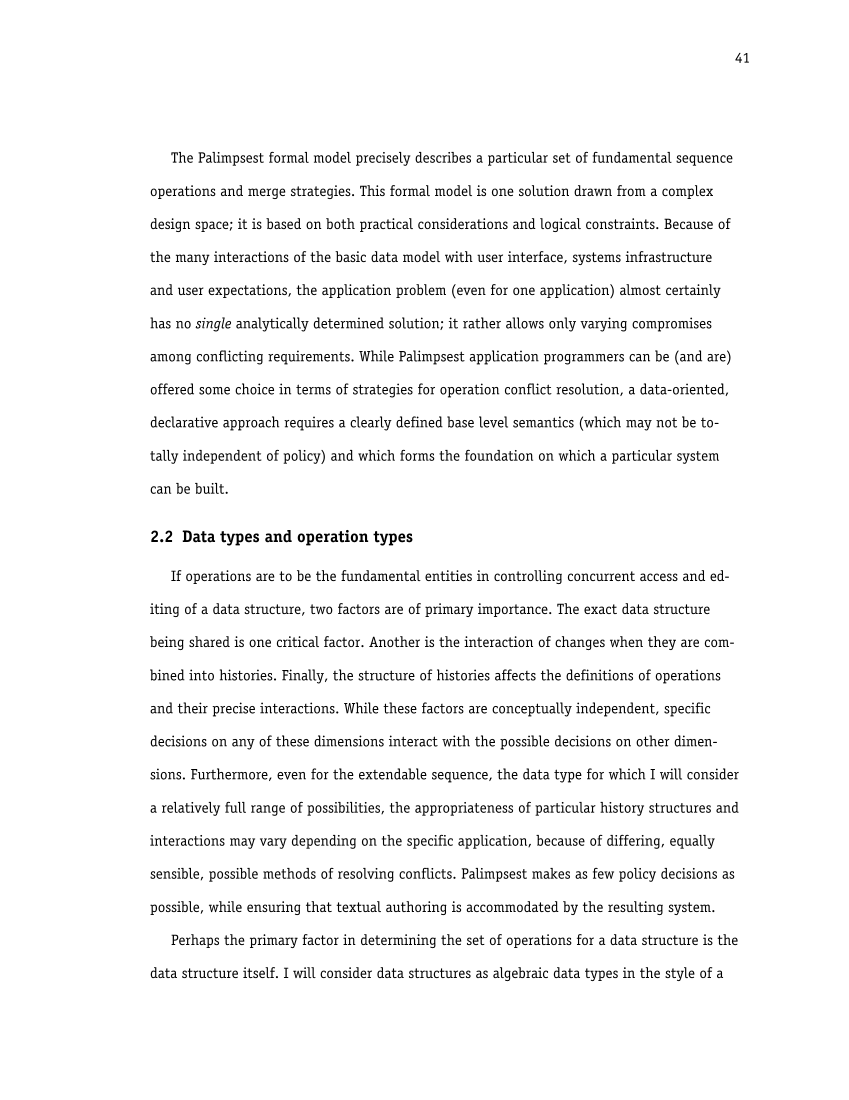41
The�Palimpsest�formal�model�precisely�describes�a�particular�set�of�fundamental�sequence
operations�and�merge�strategies.�This�formal�model�is�one�solution�drawn�from�a�complex
design�space;�it�is�based�on�both�practical�considerations�and�logical�constraints.�Because�of
the�many�interactions�of�the�basic�data�model�with�user�interface,�systems�infrastructure
and�user�expectations,�the�application�problem�(even�for�one�application)�almost�certainly
has�no�singleanalytically�determined�solution;�it�rather�allows�only�varying�compromises
among�conflicting�requirements.�While�Palimpsest�application�programmers�can�be�(and�are)
offered�some�choice�in�terms�of�strategies�for�operation�conflict�resolution,�a�data-oriented,
declarative�approach�requires�a�clearly�defined�base�level�semantics�(which�may�not�be�to-
tally�independent�of�policy)�and�which�forms�the�foundation�on�which�a�particular�system
can�be�built.
2.2 Data�types�and�operation�types
If�operations�are�to�be�the�fundamental�entities�in�controlling�concurrent�access�and�ed-
iting�of�a�data�structure,�two�factors�are�of�primary�importance.�The�exact�data�structure
being�shared�is�one�critical�factor.�Another�is�the�interaction�of�changes�when�they�are�com-
bined�into�histories.�Finally,�the�structure�of�histories�affects�the�definitions�of�operations
and�their�precise�interactions.�While�these�factors�are�conceptually�independent,�specific
decisions�on�any�of�these�dimensions�interact�with�the�possible�decisions�on�other�dimen-
sions.�Furthermore,�even�for�the�extendable�sequence,�the�data�type�for�which�I�will�consider
a�relatively�full�range�of�possibilities,�the�appropriateness�of�particular�history�structures�and
interactions�may�vary�depending�on�the�specific�application,�because�of�differing,�equally
sensible,�possible�methods�of�resolving�conflicts.�Palimpsest�makes�as�few�policy�decisions�as
possible,�while�ensuring�that�textual�authoring�is�accommodated�by�the�resulting�system.
Perhaps�the�primary�factor�in�determining�the�set�of�operations�for�a�data�structure�is�the
data�structure�itself.�I�will�consider�data�structures�as�algebraic�data�types�in�the�style�of�a
The�Palimpsest�formal�model�precisely�describes�a�particular�set�of�fundamental�sequence
operations�and�merge�strategies.�This�formal�model�is�one�solution�drawn�from�a�complex
design�space;�it�is�based�on�both�practical�considerations�and�logical�constraints.�Because�of
the�many�interactions�of�the�basic�data�model�with�user�interface,�systems�infrastructure
and�user�expectations,�the�application�problem�(even�for�one�application)�almost�certainly
has�no�singleanalytically�determined�solution;�it�rather�allows�only�varying�compromises
among�conflicting�requirements.�While�Palimpsest�application�programmers�can�be�(and�are)
offered�some�choice�in�terms�of�strategies�for�operation�conflict�resolution,�a�data-oriented,
declarative�approach�requires�a�clearly�defined�base�level�semantics�(which�may�not�be�to-
tally�independent�of�policy)�and�which�forms�the�foundation�on�which�a�particular�system
can�be�built.
2.2 Data�types�and�operation�types
If�operations�are�to�be�the�fundamental�entities�in�controlling�concurrent�access�and�ed-
iting�of�a�data�structure,�two�factors�are�of�primary�importance.�The�exact�data�structure
being�shared�is�one�critical�factor.�Another�is�the�interaction�of�changes�when�they�are�com-
bined�into�histories.�Finally,�the�structure�of�histories�affects�the�definitions�of�operations
and�their�precise�interactions.�While�these�factors�are�conceptually�independent,�specific
decisions�on�any�of�these�dimensions�interact�with�the�possible�decisions�on�other�dimen-
sions.�Furthermore,�even�for�the�extendable�sequence,�the�data�type�for�which�I�will�consider
a�relatively�full�range�of�possibilities,�the�appropriateness�of�particular�history�structures�and
interactions�may�vary�depending�on�the�specific�application,�because�of�differing,�equally
sensible,�possible�methods�of�resolving�conflicts.�Palimpsest�makes�as�few�policy�decisions�as
possible,�while�ensuring�that�textual�authoring�is�accommodated�by�the�resulting�system.
Perhaps�the�primary�factor�in�determining�the�set�of�operations�for�a�data�structure�is�the
data�structure�itself.�I�will�consider�data�structures�as�algebraic�data�types�in�the�style�of�a





























































































































































































